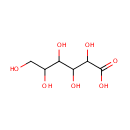| Synonyms: | - (2R,3S,4R,5R)-2,3,4,5,6-pentahydroxyhexanoate
- (2R,3S,4R,5R)-2,3,4,5,6-pentahydroxyhexanoic acid
- 2,3,4,5,6-Pentahydroxyhexanoate
- 2,3,4,5,6-Pentahydroxyhexanoic acid
- Altronate
- Altronic acid
- D-Altronate
- D-Altronic acid
- D-Galactonate
- D-Galactonic acid
- D-Gluco-hexonate
- D-Gluco-hexonic acid
- D-Gluconate
- D-Gluconic acid
- D-Mannonate
- D-Mannonic acid
- Galactonate
- Galactonic acid
- Gluconate
- Gluconate, technical
- Gluconic acid
- Gluconic acid, technical
- Gulonate
- Gulonic acid
- Hexonate
- Hexonic acid
- L-Galactonate
- L-Galactonic acid
- L-Gulonate
- L-Gulonic acid
- L-Idonate
- L-Idonic acid
- Mannonate
- Mannonic acid
|
|---|
| References: |
- Kanehisa, M., Goto, S., Sato, Y., Furumichi, M., Tanabe, M. (2012). "KEGG for integration and interpretation of large-scale molecular data sets." Nucleic Acids Res 40:D109-D114. Pubmed: 22080510
- Keseler, I. M., Collado-Vides, J., Santos-Zavaleta, A., Peralta-Gil, M., Gama-Castro, S., Muniz-Rascado, L., Bonavides-Martinez, C., Paley, S., Krummenacker, M., Altman, T., Kaipa, P., Spaulding, A., Pacheco, J., Latendresse, M., Fulcher, C., Sarker, M., Shearer, A. G., Mackie, A., Paulsen, I., Gunsalus, R. P., Karp, P. D. (2011). "EcoCyc: a comprehensive database of Escherichia coli biology." Nucleic Acids Res 39:D583-D590. Pubmed: 21097882
- Kim, C. H., Han, S. H., Kim, K. Y., Cho, B. H., Kim, Y. H., Koo, B. S., Kim, Y. C. (2003). "Cloning and expression of pyrroloquinoline quinone (PQQ) genes from a phosphate-solubilizing bacterium Enterobacter intermedium." Curr Microbiol 47:457-461. Pubmed: 14756528
- Linster, C. L., Van Schaftingen, E. (2007). "Vitamin C. Biosynthesis, recycling and degradation in mammals." FEBS J 274:1-22. Pubmed: 17222174
- van der Werf, M. J., Overkamp, K. M., Muilwijk, B., Coulier, L., Hankemeier, T. (2007). "Microbial metabolomics: toward a platform with full metabolome coverage." Anal Biochem 370:17-25. Pubmed: 17765195
- Winder, C. L., Dunn, W. B., Schuler, S., Broadhurst, D., Jarvis, R., Stephens, G. M., Goodacre, R. (2008). "Global metabolic profiling of Escherichia coli cultures: an evaluation of methods for quenching and extraction of intracellular metabolites." Anal Chem 80:2939-2948. Pubmed: 18331064
|
|---|


